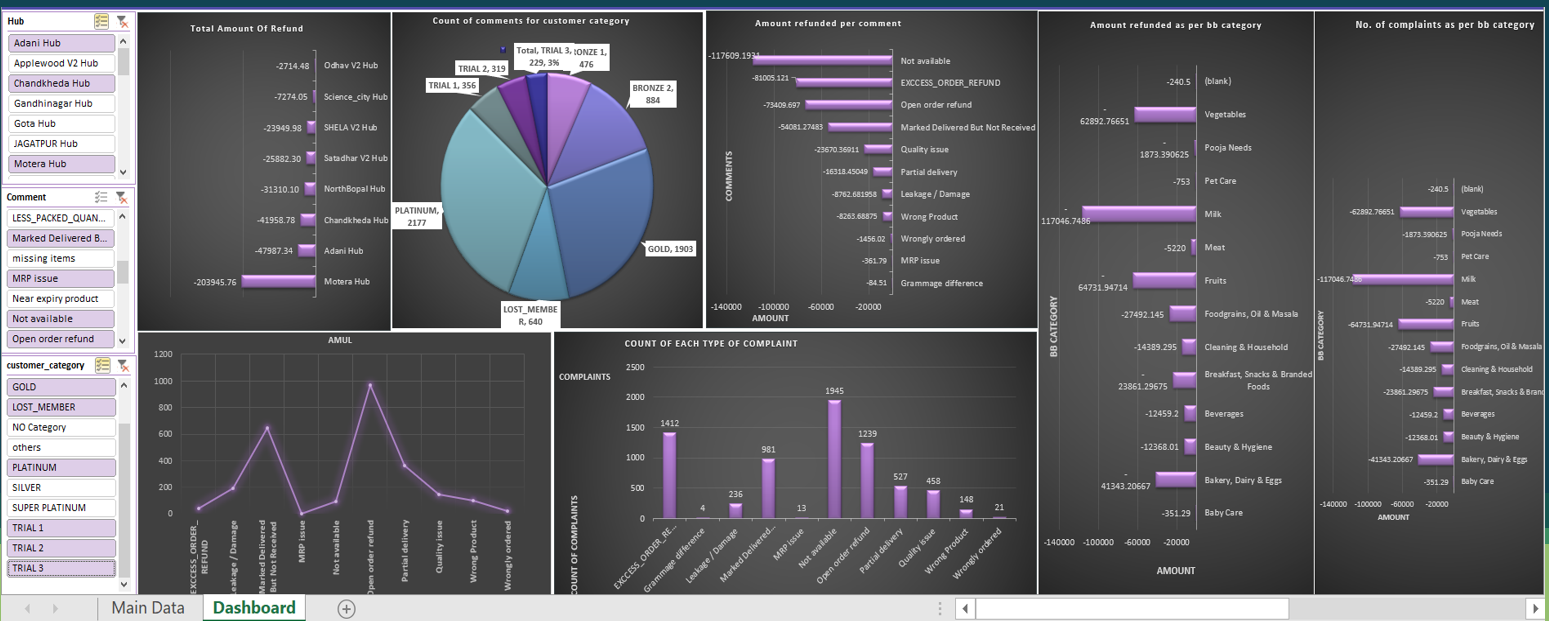Churn Analysis and Retention Strategy in a Subscription-Based FMCG Model
Explored the reasons behind customer churn through data-driven market research, identifying behavioral and operational pain points. Developed targeted action points to minimize drop-offs and strengthen customer loyalty.
Overview
This project focused on analyzing customer churn and complaints for BB Daily, Big Basket’s subscription-based FMCG service, to identify churn drivers and recommend actionable strategies to improve retention.
My role spanned end-to-end data analysis and on-the-ground engagement: I collected, cleaned, and analyzed customer, delivery, and refund data; studied operations, the competitor landscape, supply chain, and customer processes; and conducted SWOT and Fishbone Diagram analyses to uncover the key factors behind churn.
Beyond data, I worked closely with the customer retention team, directly speaking with customers to understand their concerns, and accompanied Business Development executives on field visits to observe customer interactions firsthand.
I also built and deployed a live churn dashboard, reducing manual reporting by 70% and enabling faster, data-driven decisions.
Using insights from both data and real-world interactions, I recommended churn-reduction strategies leveraging NPS, CLV, and root cause analysis, projected to reduce churn by 10–15%.
This combination of analytical rigor and hands-on experience allowed me to deliver actionable recommendations that drive measurable value for the business and its customers.
Objectives
- • Identify top drivers of churn across product, subscription, and service experience.
- • Analyze data to find patterns and trends in customer behavior.
- • Develop actionable insights to improve retention and engagement.
- • Provide data-driven recommendations for strategic decision-making.
Methodology
1. Data Sources
- Customer orders, refunds, and complaints
- Delivery windows and performance data
2. Techniques & Tools
- Techniques: Cohorting, time-series analysis, contribution analysis, churn analysis, competitor & SWOT assessment, Fishbone Diagram for root cause analysis
- Tools: Excel, Google Sheets, Tableau, Customer Insights platforms
3. Deliverable
- Interactive Retention & Complaints Dashboard
- Consolidates churn, refund, and delivery insights
- Enables faster, data-driven decisions and actionable recommendations
Key Findings
- 65% of churn linked to subscription changes and reduced product need.
- Major refund losses (~₹2.1M) stemmed from less packed quantity and damaged products.
- 31% of deliveries were delayed across key hubs, directly impacting customer satisfaction.
- Trial and Bronze users experienced 25–35% higher churn than premium segments.
- Competitor benchmarks revealed gaps in delivery speed and product availability, highlighting opportunities for service improvement.
Dashboard
Built and deployed an interactive retention & complaints dashboard that consolidates churn, refund, and delivery insights, reducing manual reporting by 70% and enabling faster, data-driven decisions.

Recommendations
1. Customer Retention
Prioritize high-value customers (Silver, Platinum & Gold) with fast refunds, personalized support, and loyalty rewards. Reduce churn during subscription changes (~65% of churn) and leverage cohort analysis for proactive retention strategies.
2. Operational Excellence
Optimize late-window delivery routes and staffing, strengthen packaging QA, and implement SKU-level refund alerts to minimize losses (~₹2.1M from damaged or under-packed products).
3. Data-Driven Insights
Use interactive dashboards to track refunds, complaints, and hub performance. Segmentation and cohort analysis identify at-risk customers and guide targeted improvements in delivery and product quality.
4. Customer Experience & Advocacy
Leverage NPS to convert Passives and Detractors into loyal customers, while Promoters become brand advocates through referrals and testimonials. Quick, fair resolution builds trust and strengthens loyalty.
5. Strategic Focus
Target high-churn hubs and societies with focused interventions, benchmark against competitors for faster delivery and product availability, and use real-time monitoring to make proactive business decisions.